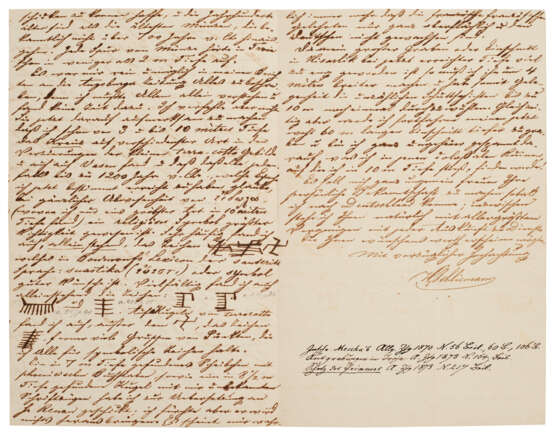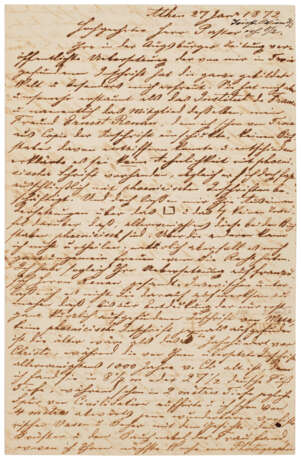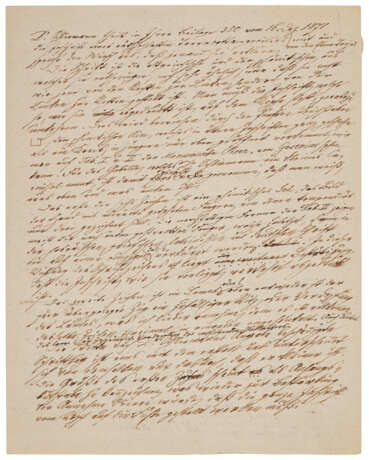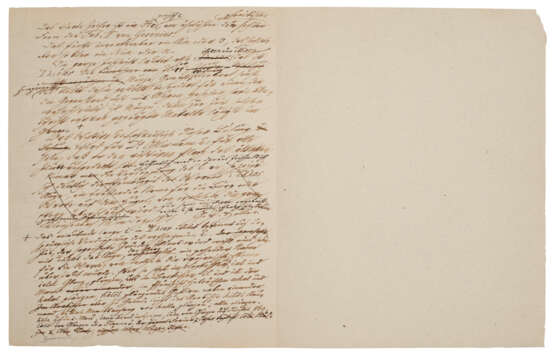ID 993218
Los 80 | SCHLIEMANN, Heinrich (1822-1890).
Schätzwert
£ 20 000 – 30 000
Autograph letter signed ('H. Schliemann') to Georg Petrus Heller, Athens, 27 January 1872.
Three pages, 130 x 200mm. With Heller’s retained copies of a letter to Schliemann, 29 March 1872 (‘... if the French do not want to see, Apollo himself cannot give them light …’), and of his article in the Augsburg Allgemeine Zeitung on 17 January 1872 about Schliemann’s work, and related printed ephemera. Provenance: Stargardt, Berlin, 2019, lot 296.
A detailed account of Schliemann’s earliest excavations at Troy, the most famous of all archaeological discoveries. A remarkable, early letter, only two months after Schliemann’s first season of excavations, pre-dating any published claim by Schliemann that he had discovered Troy, and including a highly significant early reference to the swastika. In acknowledging Heller’s article about Schliemann’s excavations — in which Heller deciphered one of the discovered inscriptions as the ancient Greek word 'Ilieon': of (or: from) Troy, written in Phoenician characters — Schliemann tells Heller ‘your translation of the inscription I found in Troy, published in Augsburger Zeitung, pleased the whole educated world, and especially me’. Despite the inability of French orientalist and Semitic scholar Ernest Renan to decipher the inscription, Schliemann states that he himself has 'no doubt' that at least two of the letters in the inscription are indeed Phoenician, and he affirms that 'the inscription you translated dates back at least 1000 BC.' Schliemann’s first season of excavations at Hisarlik had ended in late November 1871, and although he sent regular reports to German and Greek newspapers, he had not yet unequivocally claimed to have discovered Troy. The claim was however made on his behalf by the pastor and amateur philologist Georg Petrus Heller, the recipient of the present letter, in an article in the Augsburg Allgemeine Zeitung of 7 January 1872.
In this historically momentous letter Schliemann communicates previously unpublished details of his discoveries at Troy. In a statement whose far-reaching cultural implications can scarcely be overstated, Schliemann here very notably writes: 'I found the cross, which was a religious symbol of the greatest importance, in various forms in the decorations of small terracotta elements and also on vases from a depth of 3 to 10 metres. All this dates back at least up to 1,200 years before Christ, which epoch I think I have now definitely reached ... Very often I also found the character [swastika symbol] standing alone, which is in Bournouf’s Lexicon of the Sanskrit language: suastika … or symbol of good wishes’. The French pioneer of Aryanism, Emile-Louis Burnouf in fact explicitly discussed the swastika symbol with Schliemann, and such discussions undoubtedly fed into Burnouf’s claim that the swastika was the essential symbol of the Aryan race. A direct line can be traced from Schliemann’s discovery of the swastika at Troy to the later Nazi co-option of the symbol, and with this letter — predating by several months any published statement by Schliemann about his swastika discoveries — we are at the very origin of the swastika’s cultural import for Europe.
The story of Heller’s article and his proclamation of the discovery of Troy is not well known to the public, or even to professional archaeologists. Though Schliemann himself points at it in a letter of 26 April 1872 -- 'I think the rumour that I discovered it [Troy] has arisen from a translation a German scholar has made of a small inscription I found here in November last at a depth of 8-1/2 metres; for he translated it Ilieon (i.e. of Troy)' – this present letter remains formally unpublished. Beyond its immense cultural relevance, this present letter contains significant information about Schliemann’s proposed excavation plans for a second season at Troy, information that is especially noteworthy given the later criticism of Schliemann’s cavalier record-keeping. Heller’s 29 March 1872 letter to Schliemann, here present in a retained copy, gives fascinating details about the philological reasoning that led Heller to translate the inscription discovered by Schliemann as the ancient Greek name for Troy ('ILIEON'); and Heller also uses the occasion of correspondence to express his view that the 'cross' symbol Schliemann so frequently encountered was in fact the ancient letter 'Tau.' Schliemann and Heller exchanged letters only on this one occasion, and this compelling and consequential archive has remained in the Heller family until only very recently.
Special notice
This lot has been imported from outside of the UK for sale and placed under the Temporary Admission regime. Import VAT is payable at 5% on the hammer price. VAT at 20% will be added to the buyer’s premium but will not be shown separately on our invoice.
| Künstler: | Heinrich Schliemann (1822 - 1890) |
|---|---|
| Herkunftsort: | Westeuropa, Deutschland, Griechenland, Asien, Europa, Türkei |
| Kategorie des Auktionshauses: | Briefe, Dokumente und Manuskripte |
| Künstler: | Heinrich Schliemann (1822 - 1890) |
|---|---|
| Herkunftsort: | Westeuropa, Deutschland, Griechenland, Asien, Europa, Türkei |
| Kategorie des Auktionshauses: | Briefe, Dokumente und Manuskripte |
| Adresse der Versteigerung |
CHRISTIE'S 8 King Street, St. James's SW1Y 6QT London Vereinigtes Königreich | |
|---|---|---|
| Vorschau |
| |
| Telefon | +44 (0)20 7839 9060 | |
| Aufgeld | see on Website | |
| Nutzungsbedingungen | Nutzungsbedingungen |








